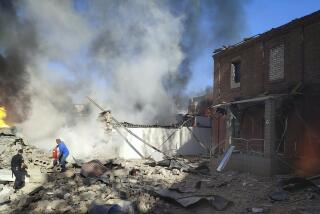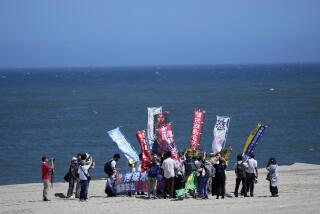U.S. officials express strong concerns about Japan nuclear crisis
- Share via
-- As the crisis continues to unfold at the Fukushima No. 1 (Daiichi) nuclear power plant, a growing disparity between Japanese and U.S. attitudes toward the problem is becoming apparent.
Whereas Japanese authorities have generally been restrained in their pronouncements about the risks, American officials are becoming increasingly vocal.
Japanese officials, for example, have consistently said the amount of radiation escaping from the damaged power plant remains relatively small. But on Wednesday, Gregory Jaczko, head of the U.S. Nuclear Regulatory Commission, said that he believes the spent fuel cooling pond atop reactor no. 4 at the facility about 150 miles north of Tokyo has boiled dry and that it is now spewing large amounts of radiation into the air.
Photos: Earthquake and nuclear crisis in Japan
“We believe that around the reactor site there are high levels of radiation,” he said. “It would be very difficult for emergency workers to get near the reactors. The doses they could experience would potentially be lethal doses in a very short period of time.”
About 180 workers are now back at the site, up from the skeleton crew of 50 who were there overnight. Jaczko later told CNN that, “This is a situation where people may be called in to sacrifice their lives. … It’s very difficult for me to contemplate that, but it’s… it may have reached that point.”
Further illustrating the split between the two countries, the U.S. military warned all its personnel in Japan not to go within 50 miles of the Fukushima No. 1 facility without specific clearance. The U.S. Embassy in Tokyo cautioned civilians within the 50-mile zone to either evacuate or stay inside their houses and keep all windows closed.
The Japanese government, in contrast, called for a much more limited evacuation of everyone living within a 12-mile radius of the plant and warned those within 18 miles to stay inside.
The government’s “repeated assurances that the [observed doses outside the plant are] too low to affect people’s health does not square with what we know,” said Dr. Ira Helfand, a past president of Physicians for Social Responsibility.
Perhaps reflecting the growing concern Thursday morning over the radiation leakage from the spent fuel pool, officials of Tokyo Electric Power Co., which owns the plant, began using helicopters to dump water onto the pool on reactor no. 4. Engineers had planned to do that Wednesday but called off the operation because steam and radioactivity rising from the pool made it too dangerous for the pilots. The helicopters, from Japan’s Self-Defense Forces, dropped water on both reactor no. 3 and the spent fuel pool on the building containing reactor no. 4.
Instead, they had hoped to shoot water into the pool using water cannons. But they have not been able to do that yet because too much debris from the tsunami and the earlier explosions is blocking the way.
The pool contains an estimated 125 tons of uranium fuel pellets, much more than is contained in any of the reactors. Moreover, the fuel rods in the pool are not enclosed in a containment vessel, so that if they start burning, radiation will escape directly into the environment.
Company officials also said they are nearing completion of a new power line that will bring electricity to the site from the grid. That will provide a consistent source of power for valves and controllers in the plant and perhaps could be used to power the pumps that supply water to the cooling ponds. It will not help the damaged reactors, however, because their cooling pumps were too badly damaged in the series of explosions that racked the three reactors that were in operation at the time of the magnitude 9.0 earthquake.
The U.S. Air Force also plans to use a Global Hawk drone based in Guam on Thursday to take high-resolution images of the plant to help officials better assess the extent of the damage. The cameras on the drone can take better pictures than are possible with manned aircraft, which have to avoid the radiation plumes at the site.
Photos: Earthquake and nuclear crisis in Japan
thomas.maugh@latimes.com
Times wire services were used in compiling this report.






